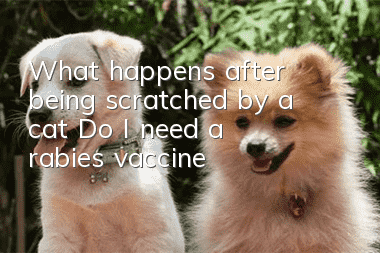What happens after being scratched by a cat? Do I need a rabies vaccine?

In daily life, people often have the experience of being scratched by domestic cats or stray cats. Because they do not understand the relevant knowledge, many people are worried about being infected with the rabies virus, so they rush to get rabies vaccinations. But what diseases will a cat scratch? What are the consequences? How to deal with it correctly? Is rabies vaccine effective?
Term explanation
Cat claw disease is caused by infection with Bartonella henselae. The pathogen is mainly caused by contact with or scratching or biting the skin of cats and other domestic animals. Bartonella henselae is a slender, polymorphic small rod-shaped bacterium with a size of (0.3~1.0) μm × (0.6~3.0) μm. It is Gram stain negative and oxidase negative. It is an aerobic bacterium with strict nutritional requirements. , grows slowly in culture medium. Bartonella henselae is found in the oropharynx of cats, and fleas are the vector of transmission in cats. It is transferred from humans to humans through scratches and bites from cats or close contact between humans and cats, causing human infection.
Clinical symptoms
Experts say that people usually develop "cat claw disease" after being scratched by pets. The specific symptom is inflammation and swelling of lymph nodes after infection. The early symptoms of the disease are blisters or small bumps that appear on the arms, hands, head and scalp within three to 10 days after being scratched. These symptoms are often mistaken for insect bites. In fact, this is a type of wound called an inoculation, through which bacteria are often introduced into the human body. About 70% of patients with the above symptoms have records of being scratched by a cat. Within two weeks of being scratched by a cat, the lymph nodes near the inoculation wound will become swollen and soft to the touch. These swollen lymph nodes are usually found in the armpits, neck, and collarbones. The diameter of the swollen lymph nodes ranges from 1 to 5 centimeters, and are accompanied by an area of redness and swelling around them. This redness and swelling of the lymph nodes can last for several months.
For most people who have been scratched by cats, red and swollen lymph nodes can indicate that they have contracted "cat claw disease", but about one-third of people who have been scratched by cats will develop more common symptoms, such as Fever above 38 degrees, fatigue, loss of appetite, headache, etc. About 14% of people who have been scratched by cats will develop some atypical symptoms of "cat claw disease", such as ulcers at the vaccination wound and swollen lymph nodes around the ears. Other possible symptoms include osteitis, pneumonia, enlarged liver and spleen, and persistent high fever for no apparent reason. These symptoms usually last about two weeks after they appear. "Cat claw disease" is slow to get better, but it can heal on its own.
Differential diagnosis
Mainly requiredVarious causes such as Epstein-Barr virus infection, Mycobacterium infection, Staphylococcus infection, beta-hemolytic streptococcus infection, sexually transmitted diseases (syphilis, chancroid, lymphogranuloma venereum, etc.), toxoplasmosis, gray gangrene, tularemia , rat bite fever, scrub typhus, sporotrichosis, sarcoidosis, brucellosis, malignant or benign lymphoma, Kawasaki disease, etc., lymph node enlargement or (and) suppuration, accompanied by eye damage Enlarged preauricular lymph nodes often indicate cat-scratch disease.
How to treat
The disease is mostly self-limiting and usually heals within 2 to 4 months. Treatment is mainly symptomatic. When lymph nodes are suppurating, the pus can be punctured and sucked to relieve symptoms. If necessary, the procedure can be repeated after 2 to 3 days. It is not advisable to incision and drainage. If the swollen lymph nodes do not shrink for more than 1 year, surgical removal may be considered. Although Bartonella henselae in vitro is sensitive or highly sensitive to many antibacterial drugs and their derivatives, aminoglycosides, rifampicin, ciprofloxacin, etc., there is no indication for the use of antibacterial drugs in general cases. For severe illnesses such as those with high fever, those with encephalitis and those with immune deficiencies (HIV infection, etc.), antibiotic combination treatment should be used in a timely manner, usually for more than 2 weeks in clinical practice.
How to prevent
The main cause of "cat claw disease" is a bacteria in cats, which can cause the above symptoms in people who have been scratched. But cats with this bacteria will not show the above symptoms. The most active seasons for this bacteria are summer and winter. There are also more cases where family members are sick at the same time. "Cat claw disease" is generally not spread from person to person. It is mainly infected through being scratched by a cat carrying this bacteria. Therefore, the main preventive measures are not to have contact with strange or unfamiliar cats, and to educate children not to play with cats at will, especially not to play with neighbor cats and cats seen outside. If scratched, wash the scratched area thoroughly with soap and water. If you have a cat at home, you may want to ask a pet doctor to trim the cat's claws to prevent your family members from being accidentally scratched.
Medical guidance
Based on the above experts and relevant scientific information, the disease "cat claw disease" caused by cat scratches is actually a bacterial source of disease and is not caused by the rabies virus at all. So there is no need for rabies vaccination. As long as we handle it in time, pay attention to disinfection and symptomatic treatment, the harm is not great at all, and some mild symptoms can even heal on their own. Pay attention to prevention, maintain cleanliness and hygiene, and create a better life where people and pets live in harmony.
- Can canine hookworm be transmitted to humans? Dogs are healthy!
- What should you do if your puppy has diarrhea just a few days old? Common dog diseases!
- What circumstances can cause a golden retriever's nose to become dry and cracked?
- Differential Diagnosis of Vomiting in Dogs
- What are the coat colors of Eurasian dogs?
- What to do if your dog accidentally eats black desiccant
- Why do dogs like to lick their owners’ faces?
- What causes a dog's dry nose? Is he sick?
- What are the common dog eye diseases? Inventory of dog eye diseases
- How big can a Chow Chow grow and is it easy to raise_Training|Price|Pictures



